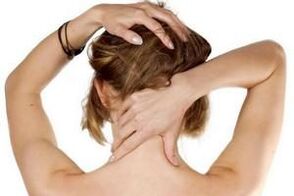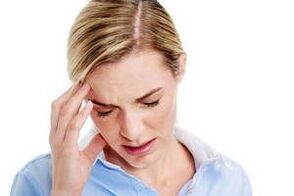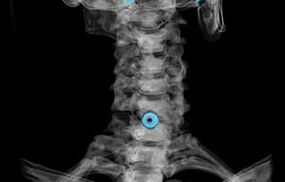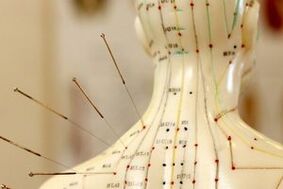Neck problems are tolerated quite weakly by humans. After all, these are difficulties in turning the head, the inability of inclinations and other problems that seriously reduce the quality of human life.

Today, osteochondrosis of the neck is seriously younger and can be observed increasingly in people from 30 to 50 years, ie the most capable population. Moreover, many do not even suspect that they have such a pathology. After all, the painful sensations appear rarely and a little. It is worth it here to understand that over time, treatment will allow you to deal with the problem and quickly regain the joy of life and presenting a person.
Description of the pathology
It must be remembered that the destructive process in the vertebrae and discs is considered irreversible. The former performance will not return to its origin. The maximum that can be done is to recognize the problem over time and slow down the destruction processes.
Cervical osteochondrosis is considered to be the most dangerous of all variants. And this is not without reason. In the end, it affects the neck, and nearby is the brain. Yes, and a huge number of vessels and fibers that feed the brain structures pass through it. In addition, the vertebrae here is very narrow with each other, which is also quite harmful. Once the slight compression of the vessels, arteries and nerve endings begins, other symptoms and manifestations of what suffer from other organs will manifest.
The vertebrae are too close to each other, and the smallest changes at least in one immediately draw changes to the other. The number of complications caused by osteochondrosis of the neck is called increased pressure, the development of vegetative-vascular dystonia, reduction of hearing and vision, as well as breathing difficulties. The most serious consequence can be a fatal result in the background of compression of the spinal cord.

How is the pathology developed
The first stage is the time when the symptoms are almost invisible. At the same time, serious changes are already active in the body - the structures of discs, vertebrae and joints begin to change. The maximum that may manifest in the form of symptoms:
- Headache
- Unpleasant sensations in the neck, arms and shoulders
- The appearance of slight restrictions on a movement in the neck
- A little and rarely visual weight loss
- Reduce the sensitivity of the collar area
The second stage is now a more serious disorder in the operation of the neck discs. Small hernias can even appear here, the intervertebral cracks begin to narrow. The pain is significantly felt against the background of compression of certain vertebrae. Symptoms during this period can be as follows:
- Neck pain
- Crunch as you turn your head
- Vision
- Tingling of the face
- Weakness in the hands
- The appearance of shootings that can be given to shoulder blades
- Sleep problems, inability to fall asleep
In the third stage, difficulties with treatment can now be noted. Hernias are formed here, the spine begins to deform, dislocations may occur among the vertebrae. The symptoms at this stage are complex. This:
- Severe pain in the neck and collar
- The inability to feel the scalp, shoulders, arms
- Paralysis of hands
- The disappearance of tendon reflexes
- The hernia of the cervical vertebrae begins to manifest itself actively
In the fourth last stage, all the symptoms of the pathology begin to worsen.
Why is such a problem occurring

There are many reasons why this pathology appears. Among them:
- Excess weight and malnutrition, in which there are many moles, marinades, etc.
- Stand problems, the presence of scoliosis, rheumatism and even flat feet
- A centenary lifestyle in which a person has a stuck work does not have a sufficient number of physics, etc.
- Neck injuries, spinal injuries
- Too active angles that for the body are novelty
- Frequent stress and serious nervous overvoltage
- Incorrect development of the cervical region
The greater part of this list leads to an increased load of the vertebrae, resulting in muscle spasm developing. Against this background, problems with blood circulation begin, and metabolism worsens. Against this background, degenerative changes are developing quite actively. The discs begin to become thinner, deformed, protruding beyond the spine.
How to recognize this disease
One must listen to recognize the initial processes of destruction in his body on time. This will quickly start therapy.
Total such symptoms and signs as: :
- By pain: the pain is localized in the neck, in the back of the head, in the shoulders, arms and even legs; If the nerve endings are associated with the pathological process, then one will feel discomfort in the shoulder area, pain in the dorsal part will occur and the restructuring of the hands is noticeable
- On the side of the hands: their restructuring occurs against the background of reducing sensitivity in the hands, damage to the spine with nerves responsible for sensitivity; Squeezes a spine that includes the motor nerves
- From the head: the appearance of a crunch with turns and inclinations, pain, etc.
- Of the general condition: feeling of impenetrable fatigue, frequent dizziness, problems with coordination, vision problems, loss of sensitivity of the tongue
Methods of pathology diagnostics
An important point for therapy is the correct diagnosis. In fact, in some of its manifestations, osteochondrosis is very similar to other pathologies. The diagnosis should be complicated and included:

- View doctor and history history
- Conducting X -Ray: This method will determine the change in mobility and arrangement of the vertebrae, provide a study of reduction of intervertebral cracks and allow you to see the deposits of the salts
- Conducting CT: This method of study is considered one of the most accurate; With his help you can see gaps, various changes that have been subjected to the disk to appreciate the instability of the vertebrae, what the compression of the nerve fibers and the brain on the back
- MRI: This method of diagnosis helps to see all pathological changes, allows you to determine the flow of blood and the condition of nerve roots
It is believed that there is sufficient information for checking and X -Ri to make an accurate diagnosis. The other options are only used in cases where the situation is not clear and there is room for doubt.
What should be the treatment
The treatment of osteochondrosis of the cervical spine should be complete and complex. This is the only way to achieve the perfect result and stop the destruction process. It is worth it here to understand that both the doctor and the patient will have to work.
First aid to exacerbate
The acute phase of the disease is found as always by accident and unexpectedly. And it's worth studying first aid methods so that you can at least get to the doctor. As a rule, the main recommendation is to place the pepper adhesive on the affected area. This measure will relieve pain. But the effect of it will be short -term.
After removing the pain that has shown sharply, you should see a doctor immediately. He will study the patient's condition, conclude conclusions about the destruction of the situation and choose adequate therapy.
Medication therapy
The diagnosis of osteochondrosis of the neck is immediately offered a whole list of medicines with different spectra of action. They all allow them to generally normalize a person's condition and bring back the joy of his life. The list includes:

- Non-steroidal anti-inflammatory drugs-I recommend using 1-2 weeks 2-3 times a day. Usually, to reduce their destructive effect on the body, such agents are advised to be used after eating
- Mussorelaxants: Similar drugs provide the best muscle tone and relieve spasms
- Diuretics: With the help of such options you can get rid of edema in the damaged area
- Corticosteroids: Medicines that reduce pain, they are especially effective for severe pain, ideally they should be prescribed with analgesics
- Blockade - are made on the basis of novocaine and lidocaine: it is usually professional therapy, ie done by doctors; During the procedure, they subcutaneously or intramuscularly introduce the medicine in several points near the injured vertebrae
- Chondroprotectors: cartilage restoration preparations
- In vitamins-the procedures are responsible for improving metabolic processes in nerve tissue, providing higher neuromuscular conductivity
It happens that local therapy is prescribed in combination with medicines. We usually talk about warming ointments.
Physiotherapy and exercise
A prerequisite for the restoration of the patient is to carry out physiotherapy sessions for the therapeutic purpose of, as well as exercise therapy. Among the non -medical means is emphasized:
- Treatment with special currents called modulated
- Reflexology
- Gymnastics with orthopedic nature
- The use of special simulators for physicism
- Massages
- Electrophoresis - In this case, the active therapeutic substances are introduced into the skin using electrodes
- Magnetotherapy
- Ultrasound
- Laser
All these methods contribute to the elimination of muscle spasm, improve the condition of the person and have a beneficial effect on his or her nervous system.
As for exercise therapy, it should not be neglected. Ultimately, moderate and deliberate physical activity will allow the muscles to tone and provide normal well -being to a person. Immediately after the exacerbation period, you can proceed with the exercises, especially since they are quite simple and accessible to all.

The list of exercise options will be offered to his patient who visits a doctor. He will make it based on the complexity of the situation and the need for certain loads. From the standard options they offer:
- Lie down with a stomach down, rest your hands. Lift your head and body slightly, but keep your back evenly, do not fail. In this position, you should stay for a few minutes and then return to the original. Repetitions must be 2-3
- Lie on the floor, stretch your hands on your body, try to touch the floor with your ear, then turn your head for the same purpose. Repeat 6-7 times
- Sitting on the floor, inhale and tilt your head to your chest, reaching it with your chin, exhale and send your head back until it stops. Repetitions of this exercise should be 10-15
It should be remembered that there should be no painful sensations during the exercise. If they occur, gymnastics should be abandoned and consult your doctor.
Homemade therapy methods
Often, folk remedies are practiced for therapeutic purposes. The recommendations of such a plan have been checked for years. For example, you can use hop ointment. It is not difficult to prepare it: you need to grind a tablespoon of 1 tablespoon powder powder. The inflamed area should be grated with such a tool and wrapped well. If the ointment is used regularly, the inflammation and the pain will pass.
The plum will be a great way. To perform them, it is enough to prepare a special infusion. Half a glass of elderberry and a few glasses of alcohol should be insisted for 7 days, putting everything in a dark place. Then it remains only to rub the infusion in the affected area.
You can make a compress literally from what is at hand. An excellent solution would be a mixture of honey and grated potatoes. The potatoes are fresh and peeled from the bark should be grated and mixed with honey. This whole table should be wrapped in gauze and placed on the neck for 20 minutes. The position of the body must be maintained stationary. It is enough to perform such a procedure once a week.
Traditional medicine should only be practiced with the permission of the attending physician. After all, there is a real risk of deterioration, but this cannot be allowed. That is why it is important to speak all the methods with the visiting specialist so that you can react on time if something goes wrong.
Surgery
It is worth preparing for the fact that surgeons intervention is possible.
Surgery is associated if the inflammation in the vertebrae has reached 3-4 stages of its development, conservative methods do not work and the human condition is rapidly deteriorating.
The operation is one of the small traumatic. A small incision is made on the neck, and then using a special microscope and microneurogical instruments is removed with a destroyed disc, replacing it with an implant. Titan plates are sometimes used to strengthen the spine in the affected area.
The duration of surgery is usually not too long - several hours. The patient may feel better the next day, and the 5th is usually prescribed. After such an intervention, the pain is left almost immediately.

Preventive measures of cervical osteochondrosis
Particular attention should be paid to preventive measures. After all, the disease is easier to warn than for treatment. And the destroyed joints should not even be restored in the initial stage. Therefore, it is worth worrying about your neck health in advance.
To prevent unpleasant consequences and pain, you should adhere to simple rules. Among them:
- Sport - Particularly good effect can show swimming, it gives a uniform load while the body itself is unloaded so that even soreness during movement is not felt here
- Review of the diet and the inclusion of more magnet and calcium products in it (these are fish and other seafood), beans, peas, seeds, milk and other products, cheese, spinach and more.
- Performing exercises right in the office during sitting work
- For sleep you have to choose a comfortable mattress and pillows
Such recommendations are possible for everyone, but at the same time they can easily prevent the development of osteochondrosis at any age. In addition, they are accessible to everyone and will not create problems to perform.
Osteochondrosis of the cervical spine is always surprised. But do not be upset immediately, you should take all the available measures that will allow you to normalize the situation and regain your health.


















